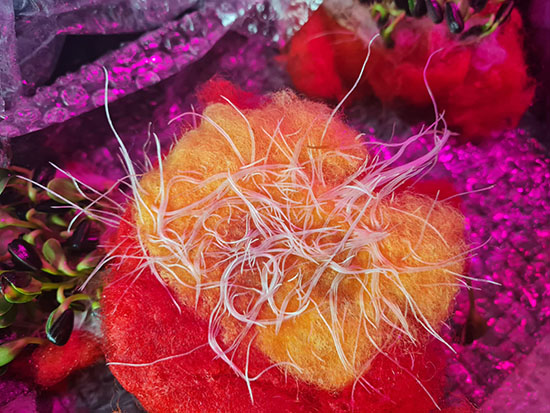Heidi Pietarinen, Field Notes – a different perspective from above the ground, work diary (detail), photography and microscope images, 2019. Photos by Heidi Pietarinen.
The new BioARTech laboratory in the Faculty of Art and Design focuses on bioart and its connections to art and research.
Where are the boundaries of bioart that utilises living material? What knowledge is left outside research? How can art-based methods be used to convert bioart into knowledge and artistic thinking?
These and other questions are addressed by the new BioARTech laboratory of the Faculty of Art and Design that combines bioart, fashion and textile art, art-based research, and biotechnology in a cross-disciplinary and cross-artistic manner. The lab is located on the third floor of the F-building. Working remotely, researchers and artists have also established a BioARTech researcher network that concentrates on growth, demise, and decomposition as trends in bioart.
"Bioart builds on evolutionary biology and the natural sciences, but a combination of art-based thinking and the processes of the natural sciences opens up new approaches to various sectors of society. Bioart centres on lifecycle thinking that leads us toward sustainable solutions and processes," notes Heidi Pietarinen, a professor of textile art and design.
In terms of methodology and theory, researchers and artists in the lab study organic matter as material, smart textiles, biotechnological methods, and various trends of art such as material-based art. They also pursue to utilise biomimicry in the development of design and innovation by imitating natural processes, materials, and structures. Their aim is also to study the concept of biophilia created by E. O. Wilson in 1984 that pertains to the human tendency to look for and experience a connection with nature and other forms of life.
Researchers of bioart and art-based methods involved
The leading researchers of the BioARTech lab are Heidi Pietarinen, Melanie Sarantou, and Satu Miettinen from the Faculty of Art and Design at the University of Lapland. They are presently studying bioart from various perspectives as part of their arts-based research.

Melanie Sarantou, Growth! – a detail from the work, felted textile and quilting using the root growth of organic material, 2021. Photo by Melanie Sarantou.
Professor Heidi Pietarinen’s research relates to her membership in the international High-Altitude Bioprospecting working group of biochemists and artists. Using the Helikite airborne device at the foot of the Saana fell, the group has examined microbial life in the subarctic stratosphere. The field work consisted of sketches, experiments, prototypes, data, and documents that the group converts into knowledge and art through art-based methods.
Professor Satu Miettinen studies the relationship between a forest, the natural environment, play, and performance. Her inspiration stems from visits to a nearby forest that she uses as a living laboratory. Miettinen is also inspired by other natural environments, where she constructs and records improvised performances. She utilised this performative method of photography for collecting material in 2020 when granted “City Cotter” residency with her colleague Taina Kontio on Vänö Island by the Association for Rural Culture and Education and the John Nurminen Foundation.
Melanie Sarantou, a senior researcher, studies fashion as an artform by updating, upcycling, and redesigning fashion clothes and artefacts found abandoned or discovered at flea markets and recycling centres. Her textile design is driven by three-dimensional and geometrical forms as well as natural environments in the north and south. Sarantou’s works consist of three-dimensional felted textiles whose forms and surfaces have been quilted using the root growths of plants.
In addition, the lab has a BioARTech exhibition group consisting of Tomi Knuutila, a lecturer of digital media; Outi Valanto, a doctoral student at the University of Lapland; and Terhi Marttila, a doctoral student at the University of Porto, Portugal. The exhibition opens in the Faculty of Art and Design in autumn 2021, featuring the rhythm, motion, and sound of data collection and the growth of organic material – all in the spirit of bioart.
Further information
Heidi Pietarinen (Professor, textiles, textile art and design), phone +358 40 484 4401
Satu Miettinen (Dean, Professor, service design), phone +358 40 484 4367
Melanie Sarantou (Senior Researcher, fashion, community-based activities and art-based methods), phone +358 40 484 4477
Email: firstname.lastname (at) ulapland.fi